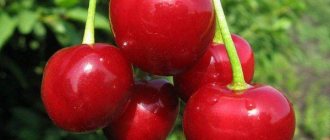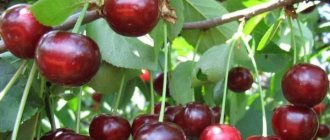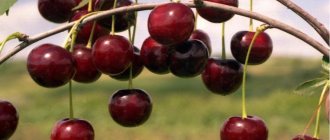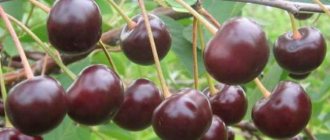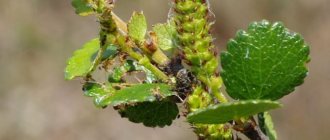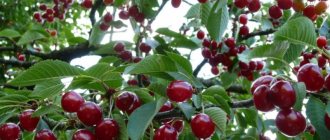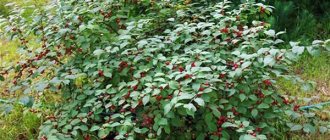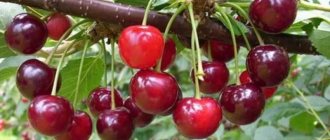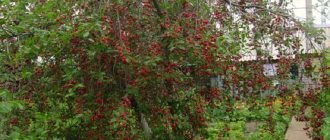Diseases and pests
“Winter pomegranate” is distinguished by its stable immunity to various diseases, and practically does not suffer from insect attacks, especially if it grows away from other crops.
In most cases, insects move to cherries from neighboring trees. To reduce infection to a minimum, a number of preventive measures are carried out:
- In spring the trunks are whitened.
- Aphids will not disturb the plant if it is treated with Oleocuprite before flowering and with Karbofos solution before flowering.
- “Aktara” protects well from weevil larvae.
- In the fall, they dig up the tree trunk circle and clear it of plant debris.
Among the diseases, cherries are susceptible to moniliosis or moniliosis burn. But this fungal disease affects the variety very rarely and only if neighboring trees are already sick. Therefore, if the fungus has settled on other crops in the garden, be sure to treat the cherry with Fitosporin-M after it has faded and begins to actively form ovaries. This will help not only save part of the harvest, but prevent the death of the tree itself.
The disease can be recognized by the following signs:
- dry, darkened branches appeared on the tree;
- half-dried foliage;
- soft areas on 3-year-old shoots;
- mummified fruits on the branches.
If the tree is sick, the main thing is not to waste time. Part of the harvest can be saved provided that treatment is started in a timely manner, that is, during the period of active flowering. Treatment is carried out in dry, windless weather. If it rains after spraying, there will be no positive effect.
Treatment is carried out as follows:
- Treat the crowns of the diseased tree with a 3% solution of Bordeaux mixture until the buds burst.
- At the same time, the trunks are whitened with a lime solution, adding a small amount of copper sulfate and an antifungal agent.
- Before flowering, the crown is sprayed with a 0.4% solution of “Zineb”; if time is wasted and the treatment is not carried out, then the flowering tree must be treated with a 1% solution of “Topsin-M”.
- Until the plant completely blooms, repeat the treatment with Topsin-M no more than 2 times with an interval of 2 weeks. After flowering, no chemical treatment is used.
To reduce the risk of moniliosis in the garden, adhere to the following rules:
- the tree trunk circle is regularly cleared of weeds, plant debris, and fallen fruits;
- carry out regular pruning - thin out the crown;
- in the spring, each tree is carefully inspected - diseased and dry branches are cut out, if there are mummified fruits left on the branches, then they are also removed;
- do not allow mechanical damage to the bark; if there are wounds or cracks, the area is cleaned and lubricated with garden varnish so that the fungus does not settle and grow;
- the plant is planted so that their branches do not touch each other and have free space between them;
- When a disease is detected, diseased branches are cut off, capturing 15 cm of a healthy area, and burned.
“Winter pomegranate” is a disease-resistant variety. We should not forget about the versatility of its fruits. Would you like to taste fresh sweet cherries, stock up on juice, jam or preserves, or make homemade liqueurs or liqueurs? "Winter Pomegranate" is your variety.
Not all gardeners are lucky enough to have a large garden. Nevertheless, I want to plant more and more of everything, including fruit and berry trees and shrubs. In such cases, low-growing varietal trees and shrubs come to the rescue. Low-growing cherry varieties, despite their compactness, are almost as productive as their tall competitors.
Main characteristics
Since Winter Pomegranate is a fairly young variety, bred through scientific selection, it combines most of the modern achievements. It was grown specifically for the northern regions, so it is characterized by high frost resistance and survival rate. The tree is unpretentious to the soil and surrounding air.
Drought resistance, frost resistance
The Winter Pomegranate variety was bred specifically for regions with cold winters. According to experienced agricultural technicians, this species can easily tolerate temperatures of 40-45 degrees below zero. Of course, such extreme conditions should not last too long, otherwise the tree's yield the following summer may be significantly reduced.
The variety is quite stress-resistant; it can easily withstand long periods of time without watering. Despite the fact that the tree is small, its roots go deep into the soil. The shallow groundwater allows the tree to have a source of water and not need watering.
Productivity
The dwarf cherry begins to bear its first fruits in the third year from the moment of planting. However, in the first few seasons the harvests will not please you with abundance. The tree will begin to bear the maximum volume of berries at 6-7 years of age. Productivity and time of fruiting can vary significantly depending on the region and plant care.
You can remove up to 10 kg of berries from one cherry
The fruits acquire a ruby color by the 2-3rd decade of July. It's best to wait about 2-3 weeks until they turn dark burgundy and sweeter. The maximum yield from one dwarf tree is up to 10 kg.
Important! Some gardeners begin harvesting in July. During this period, the fruits are not yet sweet and ripe enough
The berries are used to prepare fruit desserts, compotes and as a separate dish. Winter pomegranate cherries are also used for winter preparations - jam, marmalade and marshmallows. Thanks to their thick skin, the fruits lend themselves well to storage, transportation and freezing.
Advantages and disadvantages
Based on the data presented, we can formulate several main advantages of growing the dwarf Winter Pomegranate cherry.
When growing such a fruit tree, farmers receive:
- high productivity in a continental climate;
- ease of transportation and storage of berries;
- frost resistance;
- early fruiting.
Despite all the apparent advantages of the dwarf Winter Pomegranate cherry, it has one serious drawback. In warm climates, it cannot compete with other varieties bred specifically for such regions. In southern Russia and Ukraine, it is better to grow other types of cherries that can benefit more from the amount of sun.
This is interesting: Soil for seedlings - how to prepare soil for cabbage, cucumbers, tomatoes, peppers and other crops
Reproduction of dwarf cherry
To propagate dwarf cherries, some gardeners use seeds. I do not recommend this method, it germinates well and produces good shoots, but it can only be used as a rootstock, since the likelihood of preserving varietal characteristics in this case is extremely small.
The best method for propagating the crop is cuttings. I make preparations at the beginning of June. The best time for the procedure is early morning.
When preparing and germinating cuttings, I adhere to the following algorithm of actions:
- I remove the lower leaves on the shoots and make an oblique cut;
- I place the workpiece in water and immediately into a biostimulating preparation containing indolylbutyric acid (Kornevin, Indolyl);
- I prepare pots with a substrate of sand and peat;
- I place cuttings in pots, compact the soil;
- I cover the cuttings with a transparent container and place them in a dark place.
I water the preparations without removing the jars. You can remove the protection after about a month. I replant it to a permanent place in open ground in the spring.
Diseases and pests
In order for a dwarf crop to consistently bear fruit and have an attractive appearance, you should monitor the appearance of signs of diseases and pests. Timely treatment and prevention will save the tree from withering.
Common diseases
Brown spot appears on the leaves in the form of brown spots, which later turn into holes. Damaged leaf plates and branches dry out and then fall off.
Fighting the disease:
- timely pruning of affected areas;
- the cut areas are cleaned with a 1% copper solution diluted in a ratio of 200 g per 10 liters of water;
- then rub the cleaned areas with fresh sorrel, doing the procedure 2-3 times every 20 minutes.
Cletesporiosis or hole spot appears in the form of black spots with a diameter of 2 mm, which lead to wilting and falling of the foliage.
Fighting the disease:
- destruction of affected areas;
- spraying the tree with a solution of copper sulfate in a proportion of 100 g per bucket of water.
Hole spot of cherry
Pests and their control
Weevils, small green beetles, feed on leaves and flower ovaries. Weevil larvae overwinter in the soil, when it gets warmer they turn into beetles and attack the tree.
Fighting bugs:
- manual insect removal;
- Irrigation with Inta-Vir: 2g per 10 liters of water.
Landing rules
The secret to the future health of the dwarf cherry Winter pomegranate is the right seedling. It is best to use 1-2 year old specimens with a well-developed root system. The stem should be straight with several branches.
Important! A young seedling adapts more easily to new conditions. Planting an adult plant most often ends in its death.
It is best to purchase seedlings from professional nurseries
Despite the fact that the dwarf tree is unpretentious to the soil, cherries grow best in loose soil that has good breathability. If the soil is loamy or sandy loam, additional fertilizers are added to it. Richer black soils do not require additives or chemicals.
Recommended timing
An important part of the procedure is preparing the planting hole. In order for the soil to be saturated with oxygen as much as possible, the site must be prepared in the fall.
The selected area is cleared of weeds and roots of former fruit trees. For the dwarf Winter Pomegranate cherry, it is not necessary to dig a hole that is too large - 60x60x60 cm is a sufficient size.
Important! Before planting, you need to make sure there are no frosts in the next week. Frost can destroy fragile cherry roots
Like other dwarf trees, Winter Pomegranate must be planted in open ground in the spring. As soon as the snow has completely melted and the soil has warmed up sufficiently, you can begin planting. In the middle zone, the ideal time for landing is the 2nd decade of April. In colder latitudes, you can plant dwarf cherries at the end of the month.
Site selection and soil preparation
A properly planted cherry will delight the gardener with rapid growth, abundant flowering and an excellent harvest. The selection of a landing site must be carefully considered. The dwarf variety loves the sun, so it is worth planting the plant in the southern parts of the site. There should be plenty of light. You should not plant Winter Pomegranate in the shade of a house and outbuildings, or behind taller trees.
Important! Do not place dwarf cherry trees next to coniferous plants - this can cause Winter Pomegranate diseases. Before planting, it is necessary to prepare favorable soil for the future tree.
Half of the soil from the planting pit is mixed with 300 g of superphosphate and 100 g of wood ash. The resulting mixture fills the bottom of the recess. Only after this the dwarf cherry seedlings are planted
Before planting, it is necessary to prepare favorable soil for the future tree. Half of the soil from the planting pit is mixed with 300 g of superphosphate and 100 g of wood ash. The resulting mixture fills the bottom of the recess. Only after this are the dwarf cherry seedlings planted.
How to plant correctly
Before planting a dwarf cherry tree, you must carefully inspect the seedling. Dry and broken branches are cut with pruning shears and treated with garden varnish. It is also worth inspecting the roots to remove rotten parts. A winter pomegranate dwarf cherry seedling is inspected for pests. If they are detected, trees must be treated with a special insecticide.
The best time to plant cherries is mid-April
Gardening experts advise activating the root system before planting. To do this, the seedling is placed in a bucket of water a day before planting. The greatest effect is achieved by adding a special root growth stimulator to the liquid.
The seedlings are placed in holes filled with special soil so that the root collar protrudes slightly above the ground level. After this, the roots are sprinkled with leaf soil. Each tree must be watered abundantly - the volume of liquid should be 20-30 liters.
Landing Features
Experts recommend planting all dwarf varieties in the spring. It is better to plant the tree on the sunny side. It should not be exposed to shadows from buildings or tall trees. It is undesirable to grow them near coniferous plants; there may be a risk of infections.
Although “Winter Pomegranate” is undemanding to soil, it will grow better on loose, water- and breathable soil. These are types of soils such as loamy, sandy loam, which must be fertilized, or clayey with the addition of sand, chernozem.
Preparation
The best planting material is a one-year or two-year-old seedling. While the plant is young, it easily adapts to the climatic conditions of the region and takes root faster.
The root system is carefully inspected before planting. Broken branches and dry, rotten roots are trimmed with pruning shears. The plant is checked for pests. If they have settled, then it is treated with suitable insecticides. Before planting in the ground, the root system is soaked in water or a growth stimulant solution for 10 hours.
The planting pit is prepared in advance in the fall. The selected area is dug up, cleared of weeds and roots, and manure is added. Then they dig a hole. The depth of the hole should be equal to half the size of the seedling. The top layer of soil is mixed with 300 g of superphosphate, 1 cup of wood ash and 1/2 of the hole is filled with this mixture. They leave everything until spring.
Planting stages
Follow the following instructions when planting a seedling:
- The earth is dug up and a mound is formed.
- A peg is driven into the center of the hole and a seedling is tied to it.
- The roots are leveled along the mound.
- Cover with earth and compact well.
- At a distance of 60 cm from the trunk, they loosen the ground in a circle, making a small mound.
- Pour out 1-2 buckets of warm water, focusing on the soil moisture.
Description of the dwarf cherry variety Winter Pomegranate
This variety of fruit tree appeared relatively recently. The Winter Pomegranate cherry variety is the result of selection by foreign farmers and scientists. Despite the short period of fame, the variety has proven itself well in the gardens of Russia and neighboring countries.
Initially, this species was bred for regions with a continental climate. It perfectly tolerates hot summers and harsh winters. In Russia, the dwarf cherry variety Winter Pomegranate can be grown in most regions - from the Moscow region to Vladivostok. The only exceptions are the northern regions, where the average temperature in summer does not fall below 10 degrees.
Winter pomegranate reaches a height of no more than 2 meters
Among other types of dwarf cherries, this one stands out for its decorative component. A special feature of the plant is its incredibly beautiful flowering period. When the crown is formed correctly, white and pink inflorescences delight the eye with lush colors.
Height and dimensions of an adult tree
Like most dwarf species, cherries are small in size. The height of an adult plant reaches 1.5-1.8 m. These dimensions provide convenience when pruning and collecting ripe fruits.
Important! On good soils, when all the necessary fertilizers are applied, the height of the tree can reach two meters or more. The trunk is divided into several main branches, from which neat shoots extend in all directions
Proper pruning, necessary to form the crown and improve fruiting, allows you to get a lush tree. The green mass in diameter can reach 1.5-2 meters
The trunk is divided into several main branches, from which neat shoots extend in all directions. Proper pruning, necessary to form the crown and improve fruiting, allows you to get a lush tree. The green mass in diameter can reach 1.5-2 meters.
Description of fruits
A feature of the variety, for which it received its poetic name, is the ability of the berries to remain on the branches until the onset of cold weather. The fruits do not fall off, remaining on the stalks until the end of October. They have a dense skin that protects them from the scorching sun, preventing baking. Other characteristics of the berries include:
- fruit weight 3.5-4 g;
- very small bone;
- sweet taste with noticeable sourness;
- color from ruby to dark burgundy.
It is worth noting that the prepared berry juice will contain about 14% sugar. Such indicators mean the absence of cloying. The fruits of this variety have the most balanced taste among their relatives.
Does the Winter Pomegranate cherry need pollinators?
The variety is self-pollinating. Even in the absence of other trees in personal plots, you can count on a fairly bountiful harvest. The best pollination occurs when there are several plants of the variety nearby.
Cherry variety Winter pomegranate – self-pollinating
Important! Even in the absence of bees, 20 to 40% of flowers will self-fertilize. Flowering begins in spring - late April or early May
It lasts about 2-3 weeks. Depending on the weather, tree maintenance conditions and the presence of natural pollinators, up to 90-95% of flowers can become berries
Flowering begins in spring - at the end of April or beginning of May. It lasts about 2-3 weeks. Depending on the weather, the conditions of the tree and the presence of natural pollinators, up to 90-95% of the flowers can become berries.
The best varieties
Since selection does not stand still, and more and more new varieties are appearing in domestic gardening, you better study the most popular varieties of dwarf cherries. This way you will make a conscious choice and will be able to create all the favorable conditions for the growth of your plant.
Anthracite
The tree, whose minimum height is about 2 m, bears fruit intensively. Large berries ripen on a rather spreading crown, which acquire a black tint as they fill. Their pulp is sweet and very tasty. Caring for the plant is not difficult, but be prepared for the fact that you will have to protect the tree from fungal diseases.
Low-growing Moscow
This two-meter plant is characterized by the presence of a dense crown, so you cannot do without annual pruning in the process of growing it. The variety is fast-growing, that is, you will harvest in July. The berries of the variety have a sweet taste and a pleasant aftertaste.
This low-growing cherry produces fairly juicy fruits with a rich color and aroma. The Businka variety is widely popular among gardeners because it is not demanding in care. It is characterized by the presence of a rounded crown. Among the key advantages of the fruit plant is its high yield (up to 10 kg of berries can be harvested from one tree). In addition, cherries from this plant can be used in making jam or compote.
Planting on Rubinovka’s personal plot is a good solution for any gardener. This fruit specimen is a dwarf hybrid of the beloved cherry. Its fruits are quite large and very tasty. This variety is partially self-fertile, so pollinating plants must be planted near the seedling. If you take into account the basic recommendations for growing, the yield of the tree will be consistently high.
Dwarf cherry Standard
Cherry on a dwarf rootstock was originally created as a shrub capable of bearing fruit even in Siberian frosts. The yield of the Standard variety is high: if 4 years after rooting the bush you also plant rootstocks, you will clearly not have a shortage of cherry berries.
This cherry is an early ripening dwarf variety - the harvest begins in June. Its fruits have a rich red hue and weigh up to 6 g. The only caveat: the presence of early flowering pollinators is mandatory for the growth of the tree. As for fungal diseases, they rarely threaten this species.
The two-meter tree forms a spherical and rather dense crown. Among the key advantages of the variety are high resistance to moniliosis and early fruit ripening. However, the yield for this fruit plant is typically low.
Latvian
What is good about this Baltic cherry variety is its ability to bear fruit generously for 25 years. However, take into account the fact that the plant blooms late. The key advantage of the Latvian variety is its high yield: up to 30 kg of berries can be harvested from one tree. They are often used in cooking because jams, preserves and compotes made from them are tasty and nutritious.
Winter pomegranate
The dwarf variety Winter Pomegranate is a godsend for a region with any climatic features: it bears fruit generously, even taking into account the harsh winter and hot summer. The Winter Pomegranate cherry variety is resistant to diseases and pest attacks. It is believed that even with minimal care of the plant, you can collect up to 10 kg of berries.
Planting good dwarf varieties on your garden plot is simply necessary if a generous harvest and not too burdensome care are acceptable to you.
Proven varieties
There are about 150 varieties of low-growing cherries. To choose the right option, you should take into account the local climate. Let's consider the varieties of dwarf cherries, which are classified as well-tolerant of the weather conditions of the Moscow region.
- Tamaris. The berries of the tree are juicy, dark red with brown dots, and slightly sour. The variety is used in cooking and is often consumed fresh. The harvest is harvested in early August.
- Quick. The tree looks like a ball due to the position of the branches. The berries, weighing 3.5-4.2 g, are burgundy in color. Solid, tolerate transportation well. It is distinguished by good early yield - the berries will ripen in early July. Prone to moniliasis.
- In memory of Mashkin. The fruits of the tree ripen in mid-July. They grow up to 5 g. The pulp is tender, sweet and sour. It is not particularly winter hardy or immune to disease.
There are varieties for Siberia and the Urals.
- Ural ruby. The height of the bush is on average about 1.5 m, the branches grow downwards. The leaves are boat-shaped and dark green in color. The berries are sweet and sour and very juicy, weighing up to 4 g. Brings up to about 10 kg of harvest per season. Ripens in August.
- Lighthouse. Relatively tall bush (up to 2 m). Self-fertile, but brings more yield in the vicinity of such varieties as Vole and Generous Cherry. The fruits are dark red with a sweet and sour taste, weigh about 6 g. Fruits in late July - early August. One bush can produce up to 15 kg.
We will consider varieties for the northern regions below.
- Winter pomegranate. Despite its name, it is a type of low-growing cherry. It is unpretentious to grow and thrives at both very low and high temperatures. Resistant to pests. Winter pomegranate is great for a novice gardener because it does not require special care and has excellent yield. In one season it can produce from 10 kg of cherries.
- Businka is a type of dwarf cherry that is particularly winter hardy. The fruits are usually bright red and small. This species is rarely eaten fresh. Most often used for canning, jam, compotes and other culinary delights. It is characterized by frost resistance, fruitfulness, and resistance to all types of pests.
- Ob. It is distinguished by its very small growth - only 1.3 m in height. The berries are small, tasty, dark red. It begins to bear fruit a year after planting. Consumed fresh, used for culinary dishes. It tolerates low temperatures and heat well, but does not tolerate pests well. Cherries do not need pollination
The key to success in growing low-growing varieties of cherries lies in the correct choice of variety. An unsuitable climate dramatically reduces the likelihood of successful tree development. The plant can be propagated by cuttings or layering. Such methods can be used only after the first harvest and 2-3 years before the end of the plant’s life.
The following rules should be followed:
- The planting site should be on the sunny side of the yard, other trees should not block the rays of the sun;
- You should not plant cherries next to coniferous trees, they can cause the development of infectious diseases;
- the soil must allow moisture to pass through well, be loose so that air can circulate, these include sandy loam, loamy soil subject to frequent fertilization, clay soil with the addition of sand, black soil;
- It should be planted on a small hill so that groundwater does not come into contact with the roots.
Preparatory stage
One- or two-year-old plants are best suited for planting. This age is the most favorable, because the trees are still very young and can easily adapt to transplantation. During this time, they have already managed to get stronger and get used to the climate.
Dry roots should be immediately removed using pruning shears and inspected for pests. If necessary, carry out treatment and place the root in water for 7-10 hours.
The soil should be prepared in advance. In the fall it needs to be dug up and fertilized with phosphorus and potassium. Then dig it up again and leave it until spring.
Planting stages
The hole for a dwarf cherry tree should be half the size of the seedling to protect it from the wind.
Landing sequence:
- drive a wooden peg into the center of the hole and tie a seedling to it;
- cover the top tightly with fertilized soil;
- make small depressions around the tree for watering;
- water with 1-2 buckets of water depending on the dryness of the soil.
Description of culture
The dwarf cherry is a squat, branched, beautiful bush that grows very quickly. Its height is 150-170 cm, but sometimes it grows up to two and a half meters. The branches are brown with a reddish tint.
Low-growing cherries are winter-hardy and have high yields. It bears fruit much earlier than the common one. Although it is small, this does not affect the yield in any way - 10-15 kg of berries from one tree per summer, sometimes up to 20. The fruits are small, sometimes of a bizarre shape, located on the branch very close to each other. When the bush blooms, you can’t even see the leaves - just one white cloud of flowers with a very pleasant aroma.
The color of the berries ranges from red to almost black; they taste sour-sweet, sometimes tart. The leaves have a pointed shape with a jagged edge, the surface is slightly rough. The bottom of the leaf has a grayish tint. And on top it can be green, orange or red, depending on the time of year.
Dwarf cherry blossoms
Note! Berries are not afraid of long transportation. This cherry is very tasty in compotes, jam, jelly, pies, and also fresh.
This cherry is very tasty in compotes, jam, jelly, pies, and also fresh.
Diseases and pests
Weevils can appear in cherry pits, and worms in berries. Cherries are also not immune to aphid attacks. In such cases, sprayers designed specifically for these types of pests are most effective.
Another common disease of dwarf cherries is monoliosis. It is caused by the development of a fungus that causes leaves to wilt prematurely and fall off.
The best solution is to trim damaged areas of the plant. They must be burned so that they do not provoke the appearance of symptoms in healthy areas of the tree.
In the spring, it is imperative to treat the infected tree even before flowering with preparations containing 3% Bordeaux mixture, copper and lime. Spray 4-5 times every two weeks.
To prevent the occurrence of diseases in dwarf cherries, it is best to feed them with mineral and organic fertilizers based on potassium, manganese, boron and zinc.
If no remedies help and the disease does not recede, then it is best to uproot it and burn it so that the fungus is not transmitted to other plants growing in the garden.
Rules of care
Dwarf cherry trees do not require special care, but they do require regular pruning.
Watering should be regulated depending on weather conditions. During the rainy season, you should periodically loosen the soil around the plant to remove excess water; no need to water. In dry weather and during fruit ripening, watering should be carried out regularly.
In spring, it is recommended to whitewash the tree trunk with lime to avoid exposure to pests. You also need to trim branches damaged after winter and treat them with ash. If the cherry tree has stopped producing fruit, you can try to attract bees for pollination artificially. Some varieties of cherries cannot pollinate on their own; in this case, you need to spray the twigs and flowers of the cherries with a weak solution of syrup.
After planting, before the first flowering, the plant should be fertilized with mixtures containing nitrogen. In summer, the tree should be fed at least 2 times with a break of at least 3 weeks.
After harvesting, care should be taken to winterize the tree. At this time, it needs to restore the content of phosphorus, calcium and potassium. If these measures are not carried out, this may affect the further development and fruiting of the tree. Premature shedding of fruits and ovaries may begin.
Dwarf cherry varieties, their description and characteristics
The key to growing dwarf cherries is choosing the right variety. Otherwise, the tree will not produce a harvest and may die. In the southern regions, you can plant cherries with average frost resistance (Lyubskaya, Vstrecha), and for the Moscow region, forms with high resistance to frost and, ideally, immunity to coccomycosis (a dangerous fungal disease widespread in this area), such as Tamaris, Anna, are suitable , Rusinka, Bystrinka. Let's look at some of the most famous varieties.
Did you know? Cherry juice is a natural sleep aid. It increases the concentration of the hormone melatonin in the blood, promoting deeper and longer sleep.
Anthracite
The fruits of this cherry become almost black when ripe, which explains its name. Large (about 5 g) sweet berries, easily separated from the stone, give Anthracite a resemblance to cherries. This is a high-yielding mid-season variety that ripens in the second half of July.
The harvest will be richer and the berries sweeter if the cherries are planted in an area well lit by the sun.
Bystrinka
Super productive early variety. The first berries can be eaten already at the beginning of July, and in total up to 20 kg of dark red berries can be harvested from the tree, which looks like a spherical shrub, per season. Bystrinka tolerates frost, transportation and storage well, but is prone to moniliosis.
Did you know? Cherry is the symbol of Utah, USA.
Bystrinka grows as a low-growing tree, and this type requires careful monitoring of the condition and shape of the crown
Mtsenskaya
A good technical variety with beautiful dark red berries weighing up to 4 g. Their pulp is juicy, the taste is average, and transportability is high, which makes Mtsenskaya an ideal raw material for juices, liqueurs, compotes and other processing. Mtsenskaya is also valued for the durability of its trees, reaching a height of 2 m.
Winter pomegranate
This is a fairly new variety, bred through the selection of so-called sand (steppe) cherries, widely cultivated in America. Winter pomegranate is exceptionally frost-hardy, self-pollinating and resistant to pests and diseases.
We recommend reading about black cherry varieties.
Its taste is good: the pulp is sweet, with a slight sourness. To enjoy the taste of Pomegranate to the fullest, you need to wait for its consumer ripeness, which occurs in August: that’s when the berries turn dark burgundy.
A pleasant bonus is the high preservation of the fruits - they can hang on the branch until the end of September. Winter pomegranate is very decorative and its trees, reaching a height of 1.5 to 2 m, will decorate any garden. If the cherry tree has stopped producing crops, you can try to attract bees for pollination artificially
Bead
Beads trees reaching 2 m can easily withstand severe frosts. The variety is high-yielding and causes little hassle associated with care and protection from pests. The berries live up to their name: they are very small (no more than 3 g), but juicy and tasty. Cherries are great for making compotes, juices and jam.
Features of care
Dwarf cherries, distinguished by their unpretentiousness, do not require special attention. Caring for the bush mainly consists of proper, timely pruning of branches and fertilizing.
Rules for pruning:
- carried out at the beginning of spring, before the buds swell: then pruning will not harm the plant, but will enhance growth;
- the first formative pruning is carried out immediately after planting - all branches are cut around the central branch at a distance of 0.5 meters from the ground;
- For non-shrub species, pruning is carried out, leaving about 5 strong branches, for shrub species - no more than 10 branches. The branches should be located symmetrically on both sides of the trunk. Broken and weak branches should be removed, the places of all cuts should be covered with ash or garden pitch;
- subsequent care is carried out taking into account the main branches, to which more shoots are added. Ultimately, there should be 10 branches per tree and 15 per bush;
- branches growing inward should be removed.
Pruning and shaping cherry trees
Feeding and watering
Caring for a dwarf variety involves watering, which is additionally carried out during drought or during intensive plant growth. Water must be added:
- during flowering;
- during the period of fruit ripening;
- when harvesting;
- autumn watering before wintering.
In summer, water the tree in the morning or evening to avoid too rapid evaporation and overheating of the root system. The liquid is applied to the tree trunk circle, 3-4 buckets per adult tree. After each watering or rain, you should loosen the soil near the trunk and mulch it with sawdust, which will help saturate the soil with oxygen and longer retain the moisture that the plant needs for a good harvest.
Fertilizers begin to be applied in the first half of spring, before flowering. Use fertilizer containing nitrogen. During flowering, it is possible to add chicken manure, which should be used to mulch the ground around the trunk. Carefully monitor the amount of organic matter, an excess of which can harm the root system.
In the summer, fertilize the soil with nitrogen-containing fertilizers at intervals of 4 weeks. After harvesting, the soil is dug up with manure.
In the autumn, fertilizers are applied to mineralize the soil and prepare the tree for winter. Use calcium and phosphorus.
Caring for "Winter Pomegranate"
To get a harvest from a tree, they organize proper care, which consists of proper watering, timely application of fertilizers and pruning of trees.
Watering
The frequency of watering depends on the weather. In rainy times, it is enough just to loosen the soil so that the roots do not suffer from a lack of oxygen.
During the dry period, during flowering and ripening of fruits, water regularly, pouring 2-3 buckets of water under each tree.
Feeding
In the first year, no fertilizing is applied, provided that the soil has been previously enriched before planting.
Next, the first fertilizing is carried out before flowering, adding nitrogen-containing fertilizers. In summer, organic fertilizers are applied to the tree trunk circle (2 times) with an interval of 3 weeks. After harvesting, restore the mineral balance of the soil using fertilizers rich in potassium, phosphorus and calcium.
Trimming
The tree needs sanitary and formative pruning. They begin to form the crown immediately after planting. All branches that are located 50 cm from the ground are removed from the trunk.
To enhance growth, pruning is carried out annually in early spring before the sap begins to flow, at the same time all broken and dried branches are removed. The sections are treated with garden varnish or dusted with ash.
No more than 10 branches are left on the tree, which should be located symmetrically on both sides of the trunk. All shoots growing inside the crown are cut out.

